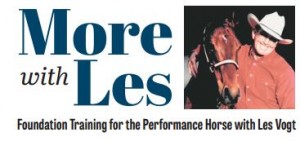 After lessons in collected stops, Les will move us this issue into Exercises 3 and 4 in his training program.
After lessons in collected stops, Les will move us this issue into Exercises 3 and 4 in his training program.
Objective
• To perfect your control of the horse’s whole body and hip
• To be able to move your horse’s body laterally without lett ing the shoulder lead
• To get to the point where you can move through exercises one through four both directions on a semi-loose rein
Things to Concentrate on
• Keeping your cues soft and relaxed so your horse stays that way too
• Making sure you have no resistance in the neck
• If you get resistance to your cues, don’t hesitate to go back to the fence
• Making sure that the shoulder never takes the first step when you cue from the rib or hip positions of these exercises
• Work up to where you can do exercises three and four on a fairly slack rein
How This Fits into the Program
Being able to control the horse’s whole body is critical to your training. In particular there are times when you’ll need to position or move the horse’s body without the shoulders leading the way or getting in the way. Here are a few:
Lead departures: To pick up the correct lead in a collected form, it is essential that you be able to isolate the horse’s hip.
Lead changes: If you’re not a perfectionist about leading with the hip in your departures, which we’ll talk about in the next lesson, you’re going to have a lot of trouble with lead changes. If a horse changes leads in the back first, it’s almost guaranteed that the front will change too. However, the reverse, changing in front first, is a gamble. If you can’t get the horse to move his hip without moving his shoulders too, changing leads from back to front will just elude you. Now is the time to really start honing that hip control.
I hope you’re starting to see how getting this body control now is making you a better rider and setting the foundation for your maneuvers and performance later on, no matter which direction you decide to go with your horse.
–Les
Leave a Comment
All fields must be filled in to leave a message.